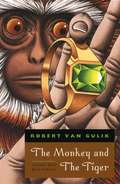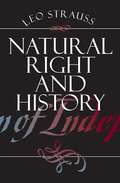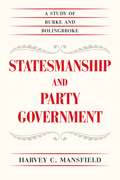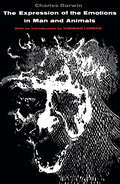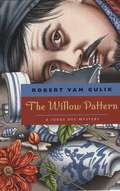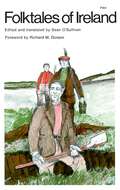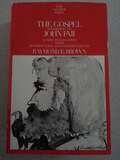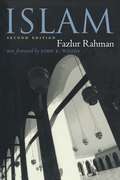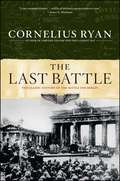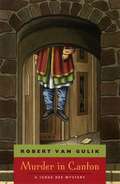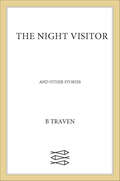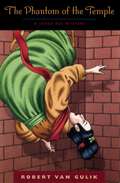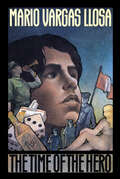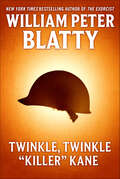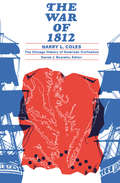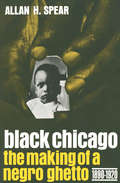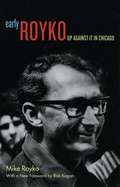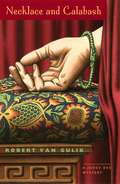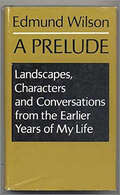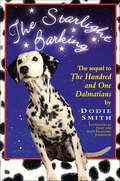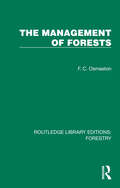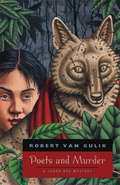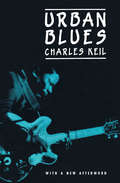- Table View
- List View
The Monkey and The Tiger: Judge Dee Mysteries (The Judge Dee Mysteries)
by Robert van GulikThe Monkey and The Tiger includes two detective stories, "The Morning of the Monkey" and "The Night of the Tiger." In the first, a gibbon drops an emerald in the open gallery of Dee's official residence, leading the judge to discover a strangely mutilated body in the woods—and how it got there. In the second, Dee is traveling to the imperial capital to assume a new position when he is separated from his escort by a flood. Marooned in a large country house surrounded by fierce bandits, Dee confronts an apparition that helps him solve a mystery.
Natural Right and History: Lectures And Essays By Leo Strauss, 1937-1946 (Walgreen Foundation Lectures)
by Leo StraussIn this classic work, Leo Strauss examines the problem of natural right and argues that there is a firm foundation in reality for the distinction between right and wrong in ethics and politics. On the centenary of Strauss's birth, and the fiftieth anniversary of the Walgreen Lectures which spawned the work, Natural Right and History remains as controversial and essential as ever. "Strauss . . . makes a significant contribution towards an understanding of the intellectual crisis in which we find ourselves . . . [and] brings to his task an admirable scholarship and a brilliant, incisive mind."—John H. Hallowell, American Political Science Review Leo Strauss (1899-1973) was the Robert Maynard Hutchins Distinguished Service Professor Emeritus in Political Science at the University of Chicago.
Statesmanship and Party Government: A Study of Burke and Bolingbroke
by Harvey C. MansfieldIn this incisive look at early modern views of party politics, Harvey C. Mansfield examines the pamphlet war between Edmund Burke and the followers of Henry St. John, First Viscount Bolingbroke during the mid-eighteenth century. In response to works by Bolingbroke published posthumously, Burke created his most eloquent advocacy of the party system. Taking an interdisciplinary approach to the material, Mansfield shows that present-day parties must be understood in the light of the history of party government. The complicated organization and the public actions of modern parties are the result, he contends, and not the cause of a great change in opinion about parties. Mansfield points out that while parties have always existed, the party government that we know today is possible only because parties are now considered respectable. In Burke’s day, however, they were thought by detractors to be a cancer in a free polity. Even many supporters of the parties viewed them as a dangerous instrument, only to be used cautiously by statesmen in dire times. Burke, however, was an early champion of the party system in Britain and made his arguments with a clear-eyed realism. In Statesmanship and Party Government, Mansfield provides a skillful evaluation of Burke’s writings and sheds light present-day party politics through a profound understanding of the historical background of the their inception.
the Expression of the Emotions in Man and Animals (Cambridge Library Collection - Darwin, Evolution And Genetics Ser.)
by Charles DarwinDarwin's work of 1872 still provides the point of departure for research in the theory of emotion and expression. Although he lacked the modern research tool of cybernetics, his basic methods have not been improved upon: the study of infants, of the insane, of paintings and sculpture, of some of the commoner animals; the use of photographs of expression submitted to different judges; and the comparative study of expression among different peoples. This new edition will be warmly welcomed by those behavioral scientists who have recently shown an intense interest in the scientific study of expression. Lay readers, too, will be struck by the freshness and directness of this book, which includes, among other data, Darwin's delightfully objective analysis of his own baby's smiles and pouts.
The Willow Pattern: A Judge Dee Mystery (The Judge Dee Mysteries)
by Robert van GulikJudge Dee has been appointed emergency governor of the plague- and drought-ridden Imperial City. As his guards help the city fend off a popular uprising, an aristocrat from one of the oldest families in China suffers an "accident" in a deserted mansion.In The Willow Pattern, the illustrious judge uses his trademark expertise to unravel the mysteries of the nobleman, a shattered vase, and a dead bondmaid. Along the way he encounters a woman who fights with loaded sleeves, a nearly drowned courtesan, and an elaborate trap set for a murderer. Packed with suspense, violence, and romance, The Willow Pattern won’t disappoint Judge Dee’s legions of loyal fans."The China of old, in Mr. van Gulik’s skilled hands, comes vividly alive again."—Allen J. Hubin, New York Times Book Review
Folktales of Ireland
by Sean O’SullivanFew countries can boast such a plentitude of traditional folktales as Ireland. In 1935, the creation of The Irish Folklore Commission set in motion the first organized efforts of collecting and studying a multitude of folktales, both written as well as those of the Irish oral tradition. The Commission has collected well over a million pages of manuscripts. Folktales of Ireland offers chief archivist Sean O'Sullivan's representation of this awe-inspiring collection. These tales represent the first English language collection of Gaelic folktales. "Without doubt the finest group of Irish tales that has yet been published in English."—The Guardian "O'Sullivan writes out of an intimacy with his subject and an instinctive grasp of the language of the originals. He tells us that his archives contain more than a million and a half pages of manuscript. If Mr. O'Sullivan translates them, I'll read them."—Seamus Heaney, New Statesman "The stories have an authentic folktale flavor and will satisfy both the student of folklore and the general reader."—Booklist
The Gospel According To John: Chapters I-xii (Anchor Bible Commentaries Ser.)
by Raymond E. BrownIn the first volume of Raymond E. Brown’s magisterial three-volume commentary on the Gospel According to John, all of the major Johannine questions—of authorship, composition, dating, the relationship of John to the Synoptics (Mark, Matthew, and Luke)—are discussed. The important theories of modern biblical scholarship concerning John are weighed against the evidence given in the text and against prevailing biblical research. In sum, what is attempted is a synthesis of the major scholarly insights that bear on the Fourth Gospel. The translation—as Father Brown states at the outset—strives not for any formal beauty but rather for an accurate and contemporary version: “the simple, everyday Greek of the Gospel has been rendered into the ordinary American English of today.” The result is a translation that will strike the reader with uncommon immediacy. Father Brown also analyzes, in the appendixes, the meaning, use, and frequency of certain key words and phrases that occur in John, and examines the differences between the Johannine and Synoptic treatments of the miracle stories. The chapters of the Gospel translated here in Volume 29 (1–12) comprise the Prologue, which opens with the famous “In the beginning was the Word,” and the Book of Signs, an account of the miracles of Jesus and of his ministry.
Islam
by Fazlur RahmanFazlur Rahman's Islam is aptly titled, in that this slim volume constitutes an incisive and surprisingly comprehensive history and analysis of Islam—its history, its conflicts, its legacy—and its prospects. From Mohammed to the late twentieth century, Rahman traces the development of Islam as a religion and, more importantly, as an intellectual tradition, offering both an easily understood introduction to the faith and an impassioned argument for its future direction.
The Last Battle: The Classic History of the Battle for Berlin (A History Bestseller)
by Cornelius RyanThe classic account of the final offensive against Hitler&’s Third Reich.The Battle for Berlin was the culminating struggle of World War II in the European theater, the last offensive against Hitler&’s Third Reich, which devastated one of Europe&’s historic capitals and marked the final defeat of Nazi Germany. It was also one of the war&’s bloodiest and most pivotal battles, whose outcome would shape international politics for decades to come. The Last Battle is Cornelius Ryan&’s compelling account of this final battle, a story of brutal extremes, of stunning military triumph alongside the stark conditions that the civilians of Berlin experienced in the face of the Allied assault. As always, Ryan delves beneath the military and political forces that were dictating events to explore the more immediate imperatives of survival, where, as the author describes it, &“to eat had become more important than to love, to burrow more dignified than to fight, to exist more militarily correct than to win.&” The Last Battle is the story of ordinary people, both soldiers and civilians, caught up in the despair, frustration, and terror of defeat. It is history at its best, a masterful illumination of the effects of war on the lives of individuals, and one of the enduring works on World War II.
Murder in Canton: A Judge Dee Mystery (The Judge Dee Mysteries)
by Robert van GulikBrought back into print in the 1990s to wide acclaim, re-designed new editions of Robert van Gulik's Judge Dee Mysteries are now available. Written by a Dutch diplomat and scholar during the 1950s and 1960s, these lively and historically accurate mysteries have entertained a devoted following for decades. Set during the T'ang dynasty, they feature Judge Dee, a brilliant and cultured Confucian magistrate disdainful of personal luxury and corruption, who cleverly selects allies to help him navigate the royal courts, politics, and ethnic tensions in imperial China. Robert van Gulik modeled Judge Dee on a magistrate of that name who lived in the seventh century, and he drew on stories and literary conventions of Chinese mystery writing dating back to the Sung dynasty to construct his ingenious plots.Murder in Canton takes place in the year 680, as Judge Dee, recently promoted to lord chief justice, is sent incognito to Canton to investigate the disappearance of a court censor. With the help of his trusted lieutenants Chiao Tai and Tao Gan, and that of a clever blind girl who collects crickets, Dee solves a complex puzzle of political intrigue and murder through the three separate subplots "the vanished censor," "the Smaragdine dancer," and "the Golden Bell." An expert on the art and erotica as well as the literature, religion, and politics of China, van Gulik also provides charming illustrations to accompany his engaging and entertaining mysteries.
The Night Visitor: And Other Stories
by B. TravenThe Night Visitor is a collection of stories by the late author B Traven.
The Phantom of the Temple: A Judge Dee Mystery (The Judge Dee Mysteries)
by Robert van GulikJudge Dee presided over his imperial Chinese court with a unique brand of Confucian justice. A near mythic figure in China, he distinguished himself as a tribunal magistrate, inquisitor, and public avenger. Long after his death, accounts of his exploits were celebrated in Chinese folklore, and later immortalized by Robert van Gulik in his electrifying mysteries. In The Phantom of the Temple, three separate puzzles—the disappearance of a wealthy merchant's daughter, twenty missing bars of gold, and a decapitated corpse—are pieced together by the clever judge to solve three murders and one complex, gruesome plot. “Judge Dee belongs in that select group of fictional detectives headed by the renowned Sherlock Holmes. I assure you it is a compliment not given frivolously.”—Robert Kirsch, Los AngelesTimes Robert Van Gulik (1910-67) was a Dutch diplomat and an authority on Chinese history and culture. He drew his plots from the whole body of Chinese literature, especially from the popular detective novels that first appeared in the seventeenth century.
The Time of the Hero: A Novel
by Mario Vargas LlosaThe action of The Time of the Hero, Nobel Prize-winning author Mario Vargas Llosa's first novel, takes place at the Leoncio Prado Military Academy in Lima, Peru. There, four angry cadets who have formed an inner circle in an attempt to ward off the boredom and stifling confinement of the military academy set off a chain of events that starts with a theft and leads to murder and suicide. The Time of the Hero presents, with great accuracy and power, the cadets' nightmare life: brutal initiation rights, poker in the latrines, drinking contests; and, above all else, the strange military code which, whether broken or followed, can only destroy.When The Time of the Hero was first published in Peru in 1962, it was considered so scandalous that a thousand copies were burned in an official ceremony at the Leoncio Prado Military Academy. That same year, the book received the Biblioteca Breve Prize, an award given to the best work of fiction in the Spanish language."…[A]s with other fine writers, Vargas functions on more than a single level of meaning." - The New York Times
Twinkle, Twinkle "Killer" Kane
by William Peter BlattyFrom William Peter Blatty, the New York Times bestselling author of The Exorcist, comes his dark comic novel about military madness, Twinkle, Twinkle, "Killer" Kane.After a nervous breakdown during a moon launch, astronaut Billy Cutshaw was committed to a military asylum and placed under the care of Colonel Hudson Kane. During their therapy sessions, Kane finds himself cross-examined about his beliefs on good and evil, forcing him to face the personal demons that have haunted him since his tour in Vietnam.This story was the basis of Blatty's later expanded novel and the Golden Globe-nominated film adaptation, both titled The Ninth Configuration.At the Publisher's request, this title is being sold without Digital Rights Management Software (DRM) applied.
The War of 1812 (The\chicago History Of American Civilization Ser. #Vol. 22)
by Harry L. Coles The Chicago History of American CivilizationThis compact history of the war attempts to separate myth from reality. Professor Coles narrates the main operations on both land and sea of the three-year struggle. He examines the conflict from the British (and Canadian) as well as the American point of view, relating events in America to the larger war going on in Europe. "A balanced analysis of tactics and strategy, this book also summarizes succinctly and clearly recent scholarship on causes and describes briefly the war's military, economic, and political consequences. Coles has surveyed thoroughly the existing literature but arrives at a number of independent judgments. It is the best single-volume account of the war in all its aspects. In recounting sea battles, Coles puts aside the patriotic blinders that have for so long prevented a sensible understanding of American capabilities and strategic necessities; thus American naval victories are put in a proper perspective. And in dealing with land engagements, he has shunned the mocking and amused attitude which has so often passed for historical judgment. Undergraduates will be stimulated by the hints of modern parallels and will find useful the excellent annotated bibliography and simple maps."—Choice
Black Chicago: The Making of a Negro Ghetto, 1890–1920
by Allan H. SpearAllan Spear explores here the history of a major Negro community during a crucial thirty-year period when a relatively fluid patter of race relations gave way to a rigid system of segregation and discrimination. This is the first historical study of the ghetto made famous by the sociological classics of St. Clair Drake, E. Franklin Frazier, and others—by the novels of Richard Wright, and by countless blues songs. It was this ghetto that Martin Luther King, Jr., chose to focus on when he turned attention to the racial injustices of the North. Spear, by his objective treatment of the results of white racism, gives an effective, timely reminder of the serious urban problems that are the legacy of prejudice.
Early Royko: Up Against It in Chicago
by Mike RoykoCombining the incisive pen of a newspaperman and the compassionate soul of a poet, Mike Royko became a Chicago institution—in Jimmy Breslin’s words, "the best journalist of his time." Early Royko: Up Against It in Chicago will restore to print the legendary columnist’s earliest writings, which chronicle 1960s Chicago with the moral vision, ironic sense, and razor-sharp voice that would remain Royko’s trademark. This collection of early columns from the Chicago Daily News ranges from witty social commentary to politically astute satire. Some of the pieces are falling-down funny and others are tenderly nostalgic, but all display Royko’s unrivaled skill at using humor to tell truth to power. From machine politicians and gangsters to professional athletes, from well-heeled Chicagoans to down-and-out hoodlums, no one escapes Royko’s penetrating gaze—and resounding judgment. Early Royko features a memorable collection of characters, including such well-known figures as Hugh Hefner, Mayor Richard J. Daley, and Dr. Martin Luther King. But these boldfaced names are juxtaposed with Royko’s beloved lesser knowns from the streets of Chicago: Mrs. Peak, Sylvester "Two-Gun Pete" Washington, and Fats Boylermaker, who gained fame for leaning against a corner light pole from 2 a.m. Saturday until noon Sunday, when his neighborhood tavern reopened for business. Accompanied by a foreword from Rick Kogan, this new edition will delight Royko’s most ardent fans and capture the hearts of a new generation of readers. As Kogan writes, Early Royko "will remind us how a remarkable relationship began—Chicago and Royko, Royko and Chicago—and how it endures."
Galahad and I Thought of Daisy
by Edmund WilsonFrom one of the leading literary critics of his generation comes the first of Edmund Wilson's three novels, I thought of Daisy, published together with his short story "Galahad." Set in Greenwich Village in the 1920s, Edmund Wilson’s I Thought of Daisy tells the coming of age story of a young man living a bohemian life, and of his heartfelt relationship with a chorus girl he meets at a party. Fictional sketches drawn from real-life literary figures are scattered throughout, including John Dos Passos and Wilson's lover, Edna St. Vincent Millay.Also included in this volume is Wilson's short story "Galahad," about the sexual awakening of a young boy at prep school."What needs to be [said] is how good, if ungainly, Daisy is, how charmingly and intelligently she tells of the speakeasy days of a Greenwich Village as red and cozy as a valentine, of lamplit islands where love and ambition and drunkenness bloomed all at once. The fiction writer in Wilson was real, and his displacement is a real loss." - John Updike
Necklace and Calabash: A Judge Dee Mystery (The Judge Dee Mysteries)
by Robert vanBrought back into print in the 1990s to wide acclaim, re-designed new editions of Robert van Gulik's Judge Dee Mysteries are now available. Written by a Dutch diplomat and scholar during the 1950s and 1960s, these lively and historically accurate mysteries have entertained a devoted following for decades. Set during the T'ang dynasty, they feature Judge Dee, a brilliant and cultured Confucian magistrate disdainful of personal luxury and corruption, who cleverly selects allies to help him navigate the royal courts, politics, and ethnic tensions in imperial China. Robert van Gulik modeled Judge Dee on a magistrate of that name who lived in the seventh century, and he drew on stories and literary conventions of Chinese mystery writing dating back to the Sung dynasty to construct his ingenious plots.Necklace and Calabash finds Judge Dee returning to his district of Poo-yang, where the peaceful town of Riverton promises a few days' fishing and relaxation. Yet a chance meeting with a Taoist recluse, a gruesome body fished out of the river, strange guests at the Kingfisher Inn, and a princess in distress thrust the judge into one of the most intricate and baffling mysteries of his career. An expert on the art and erotica as well as the literature, religion, and politics of China, van Gulik also provides charming illustrations to accompany his engaging and entertaining mysteries.
A Prelude: Landscapes, Characters and Conversations from the Earlier Years of My Life
by Edmund WilsonThe leading literary critic Edmund Wilson shares his travels and adventures from his young life in this intellectual autobiography, A Prelude.From his early childhood in Red Bank, New Jersey, to his undergraduate years in Princeton, to his later time spent in the army, this personal study, told partly in diary form, provides an illuminating look inside the mind of one of the twentieth century's towering man of letters. Also included in this volume is two short stories by Wilson, both based on actual events: "The Death of a Soldier," about the death of a young soldier from pneumonia just before going to the front. And "Lieutenant Franklin" concerning a young officer in the Army of Occupation in Germany after the war.
The Starlight Barking: The Sequel to The Hundred and One Dalmatians
by Dodie SmithDodie Smith's The Hundred and One Dalmatians, adapted by Disney, was declared a classic when first published in 1956. The Starlight Barking, Dodie's own long-forgotten sequel, presents a thrilling adventure for Pongo and his family, lavishly illustrated by the same artist team as the first book.As the story opens, every living creature except dogs is gripped by an enchanted sleep. One of the original Dalmatian puppies, all grown up since the first novel, is now the Prime Minister's mascot. Relying on her spotted parents for guidance, she assumes emergency leadership for the canine population of England. Awaiting advice from Sirius, the Dog Star, dogs of every breed crowd Trafalgar Square to watch the evening skies. The message they receive is a disturbing proposition, one that might forever destroy their status as "man's best friend."
Who We Be: The Colorization of America
by Jeff ChangRace. A four-letter word. The greatest social divide in American life, a half-century ago and today.During that time, the U.S. has seen the most dramatic demographic and cultural shifts in its history, what can be called the colorization of America. But the same nation that elected its first Black president on a wave of hope—another four-letter word—is still plunged into endless culture wars. How do Americans see race now? How has that changed—and not changed—over the half-century? After eras framed by words like "multicultural" and "post-racial," do we see each other any more clearly? Who We Be remixes comic strips and contemporary art, campus protests and corporate marketing campaigns, Martin Luther King, Jr. and Trayvon Martin into a powerful, unusual, and timely cultural history of the idea of racial progress. In this follow-up to the award-winning classic Can't Stop Won't Stop: A History of the Hip-Hop Generation, Jeff Chang brings fresh energy, style, and sweep to the essential American story.
The Management of Forests (Routledge Library Editions: Forestry)
by F. C. OsmastonOriginally published in 1968, this book discusses the principles and methods on which forest management has been founded in the past and how these principles and methods still apply or are affected by modern management skills, changing demands, social habits and resources. The book is concerned mainly with the technical aspects of forestry and the classic foundations of management. To a lesser degree it deals with commercial efficiency, labour relations and the implications of these. The historical chapter shows the tends in the development of forestry, particularly in Europe.
Poets and Murder: A Judge Dee Mystery (The Judge Dee Mysteries)
by Robert van GulikJudge Dee, the master detective of seventh-century China, sets out to solve a puzzling double murder and discovers complex passions lurking beneath the placid surface of academic life. A mild-mannered student is rumored to have been slain by a fox-demon, while a young dancer meets her death as she dresses to perform for the magistrate's illustrious dinner guests—an obese Zen monk revered for his calligraphy, a beautiful poetess accused of murder, and the past president of the imperial academy. To connect the present crimes with betrayals and adulteries from decades past, the clever judge must visit a high-class brothel and the haunted shrine of the Black Fox. From the moment the young scholar is found dead on the eve of the Autumn Festival, the pace never lets up. "The China of old, in Mr. van Gulik's skilled hands, comes vividly alive again."—Allen J. Hubin, New York Times Book Review "If you have not yet discovered Judge Dee, I envy you that initial pleasure. . . . For the magistrate of Poo-yang belongs in that select group headed by Sherlock Holmes."—Robert Kirsch, Los Angeles Times
Urban Blues
by Charles KeilCharles Keil examines the expressive role of blues bands and performers and stresses the intense interaction between performer and audience. Profiling bluesmen Bobby Bland and B. B. King, Keil argues that they are symbols for the black community, embodying important attitudes and roles—success, strong egos, and close ties to the community. While writing Urban Blues in the mid-1960s, Keil optimistically saw this cultural expression as contributing to the rising tide of raised political consciousness in Afro-America. His new Afterword examines black music in the context of capitalism and black culture in the context of worldwide trends toward diversification. "Enlightening. . . . [Keil] has given a provocative indication of the role of the blues singer as a focal point of ghetto community expression."—John S. Wilson, New York Times Book Review"A terribly valuable book and a powerful one. . . . Keil is an original thinker and . . . has offered us a major breakthrough."—Studs Terkel, Chicago Tribune "[Urban Blues] expresses authentic concern for people who are coming to realize that their past was . . . the source of meaningful cultural values."—Atlantic "An achievement of the first magnitude. . . . He opens our eyes and introduces a world of amazingly complex musical happening."—Robert Farris Thompson, Ethnomusicology "[Keil's] vigorous, aggressive scholarship, lucid style and sparkling analysis stimulate the challenge. Valuable insights come from treating urban blues as artistic communication."—James A. Bonar, Boston Herald
